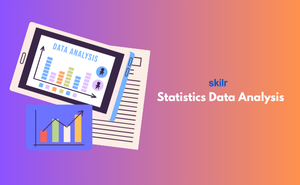👇 CELEBRATE CLOUD SECURITY DAY 👇
00
HOURS
00
MINUTES
00
SECONDS

Statistics Data Analysis is the practice of collecting, organizing, interpreting, and presenting data to know patterns, trends, and generate insights. The practice uses hypothesis testing, regression analysis, and predictive modeling for taking data-driven decisions. It is used in finance, healthcare, marketing, and research.
Certification in Statistics Data Analysis certifies your skills and knowledge in applying statistical methods and tools to analyze and interpret data. This certification assess you in statistical concepts, techniques, and using statistical software.
Why is Statistics Data Analysis certification important?
Who should take the Statistics Data Analysis Exam?
Statistics Data Analysis Certification Course Outline
The course outline for Statistics Data Analysis certification is as below -
Industry-endorsed certificates to strengthen your career profile.
Start learning immediately with digital materials, no delays.
Practice until you’re fully confident, at no additional charge.
Study anytime, anywhere, on laptop, tablet, or smartphone.
Courses and practice exams developed by qualified professionals.
Support available round the clock whenever you need help.
Easy-to-follow content with practice exams and assessments.
Join a global community of professionals advancing their skills.
(Based on 636 reviews)
Statistics is used to process complex problems in the real world so that Data Scientists and Analysts can search for meaningful trends and changes in Data. In simple words, Statistics can be used to get meaningful insights from data by performing mathematical computations on it.
There are no sharp upturns or downturns. This could suggest that data science will not just abruptly disappear in the near future. All things considered, there would be a slow decline after some time, of which there right now isn't really any proof.
You can think about the data increase from IoT or social data at the edge. Assuming we look somewhat more ahead, the US Bureau of Labor Statistics predicts that by 2026—so around six years from now—there will be 11.5 million jobs in data science and analytics.